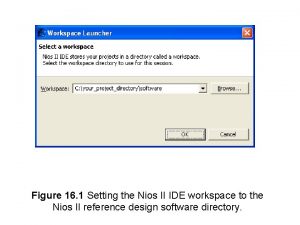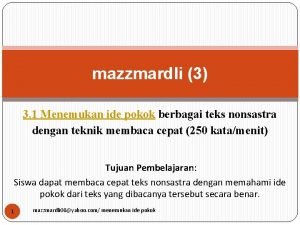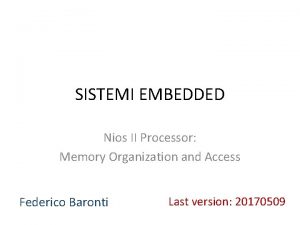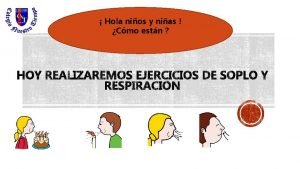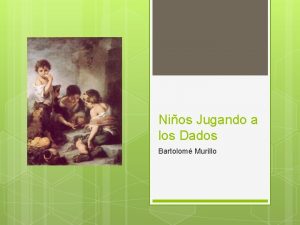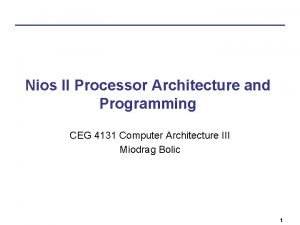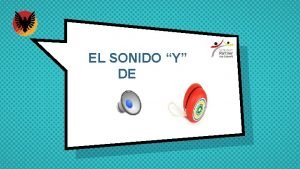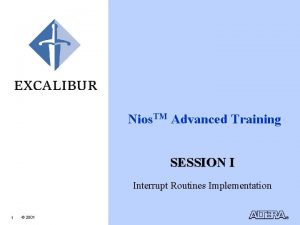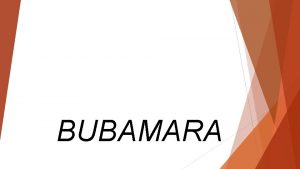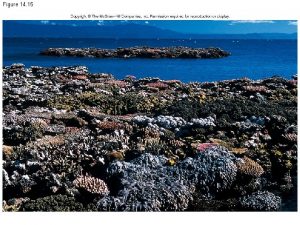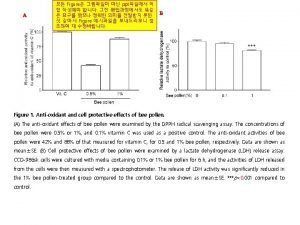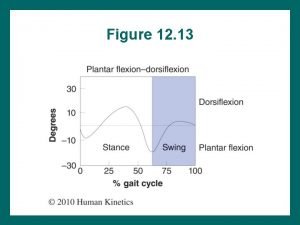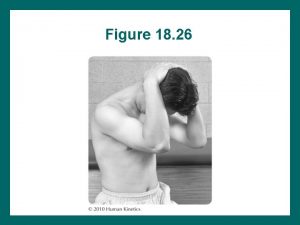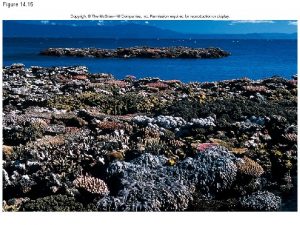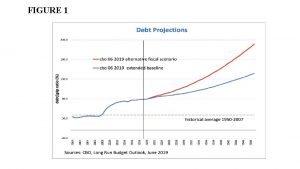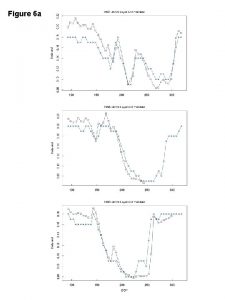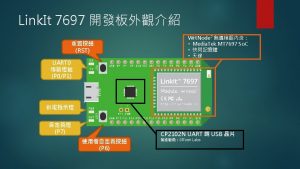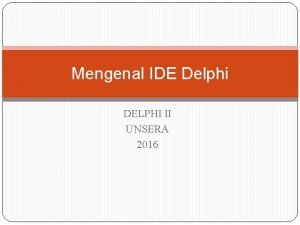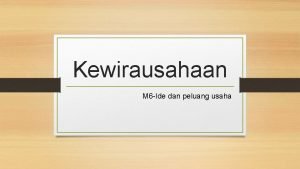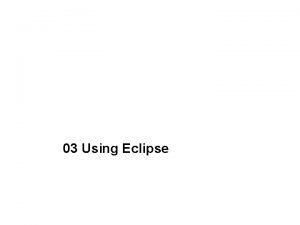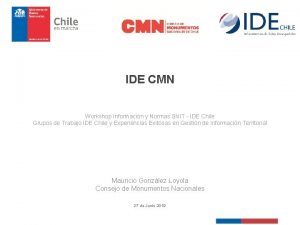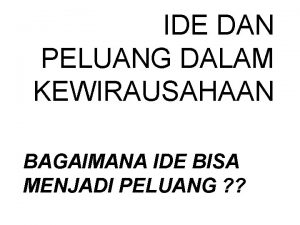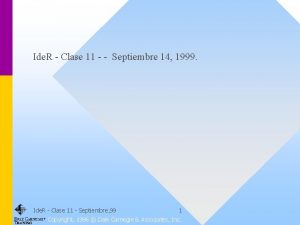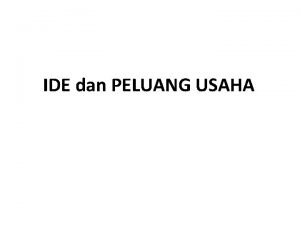Figure 16 1 Setting the Nios II IDE















![alt_u 32 test_lcd( void ) { int i; char message[17] = "Counting. . . alt_u 32 test_lcd( void ) { int i; char message[17] = "Counting. . .](https://slidetodoc.com/presentation_image_h/b9c0bc0fafc2cc852bbf336d7d97a165/image-16.jpg)










- Slides: 26

Figure 16. 1 Setting the Nios II IDE workspace to the Nios II reference design software directory.

Figure 16. 2 Create a blank project for the Nios II reference design.

Figure 16. 3 These are the system library settings that should be used for this tutorial.

#include “system. h” #include “altera_avalon_timer_regs. h” int main( void ) { IOWR_ALTERA_AVALON_TIMER_PERIODL( TIMER 0_BASE, (48000000 & 0 x. FFFF) ); IOWR_ALTERA_AVALON_TIMER_PERIODH( TIMER 0_BASE, ((48000000>>16) & 0 x. FFFF) ); IOWR_ALTERA_AVALON_TIMER_STATUS( TIMER 0_BASE, 0 ); IOWR_ALTERA_AVALON_TIMER_CONTROL( TIMER 0_BASE, 0 x 4 ); while( (IORD_ALTERA_AVALON_TIMER_STATUS( TIMER 0_BASE ) & ALTERA_AVALON_TIMER_STATUS_TO_MSK) == 0 ) {} } Figure 16. 4 This is the C code necessary for providing a one second delay by directly accessing the system timer’s registers. The timer peripheral in this system is called timer 0.

#include <sys/alt_alarm. h> int main( void ) { int first_val, second_val; second_val = 0; first_val = alt_nticks(); while( (second_val – first_val) < 1000000 ) { second_val = alt_nticks(); } } Figure 16. 5 This is the C code necessary for providing a one second delay by using the HAL interface functions.

#include <unistd. h> int main( void ) { usleep( 1000000 ); } Figure 16. 6 This is the C code necessary for providing a one second delay by using the standard ANSI C library functions

#ifndef _RPDS_SOFTWARE_H_ #define _RPDS_SOFTWARE_H_ #include <stdio. h> #include <unistd. h> #include "system. h" #include "altera_avalon_pio_regs. h" #endif //_RPDS_SOFTWARE_H_ Figure 16. 7 This is your first C program’s main header file.

#include “rpds_software. h” int main( void ) { unsigned char led_val = 1; /* Print message to the Nios II IDE console via UART */ printf( "Hello Worldn" ); while(1) { /* Output a 4 -bit value to the LEDs */ IOWR_ALTERA_AVALON_PIO_DATA( LEDS_BASE, (led_val & 0 x. F) ); if( led_val == 8 ) led_val = 1; else led_val = led_val << 1; /* Wait for 0. 5 seconds */ usleep( 500000 ); } return(0); } Figure 16. 8 This is your first C program’s main source file.

Figure 16. 9 Keep this dialog box open as long as the FPGA is being used.

Figure 16. 10 Since this project uses the same Nios II processor as your first program, the same system library can be used. Select the rpds_software_syslib from the list of available libraries.

#ifndef _RPDS_UP 3_TEST_H_ #define _RPDS_UP 3_TEST_H_ #include <stdio. h> #include <unistd. h> #include "system. h" #include "alt_types. h" #include "sys/alt_irq. h" #include "sys/alt_flash. h" #include "altera_avalon_pio_regs. h" #endif //_RPDS_UP 3_TEST_H_ Figure 16. 11 This is the beginning of your C program’s main header file.

Table 16. 1 Pushbutton to Device Mapping for Sample C Program Pus hb Perip ut her al to ns to Te (4 -32 st 1) LCD 000 Dis

#include “rpds_up 3_test. h” int main( void ) { volatile int function = 0; int ret_val; while(1) { switch( function ) { case 0 x 1: /* Test the LCD display */ ret_val = test_lcd(); break; case 0 x 2: /* Test the SRAM */ ret_val = test_sram(); break; case 0 x 4: /* Test the Flash memory */ ret_val = test_flash(); break; case 0 x 8: /* Test the SDRAM */ ret_val = test_sdram(); break; default: /* Do nothing */ break; } function = 0; usleep( 50000 ); /* Wait 50 ms */ } return(0); } Figure 16. 12 This is the beginning of your C program’s main source file.

static void buttons_isr( void* context, alt_u 32 id ) { volatile int *function = (volatile int*) context; *function = IORD_ALTERA_AVALON_PIO_EDGE_CAP( BUTTONS_BASE ); IOWR_ALTERA_AVALON_PIO_EDGE_CAP( BUTTONS_BASE, 0 ); IOWR_ALTERA_AVALON_PIO_IRQ_MASK( BUTTONS_BASE, 0 x. F ); } Figure 16. 13 This is the interrupt service routine for the pushbuttons.

void lcd_init( void ) { /* Set Function Code Four Times -- 8 -bit, 2 line, 5 x 7 mode */ IOWR( LCD_BASE, LCD_WR_COMMAND_REG, 0 x 38 ); usleep(4100); /* Wait 4. 1 ms */ IOWR( LCD_BASE, LCD_WR_COMMAND_REG, 0 x 38 ); usleep(100); /* Wait 100 us */ IOWR( LCD_BASE, LCD_WR_COMMAND_REG, 0 x 38 ); usleep(5000); /* Wait 5. 0 ms */ IOWR( LCD_BASE, LCD_WR_COMMAND_REG, 0 x 38 ); usleep(100); /* Set Display to OFF */ IOWR( LCD_BASE, LCD_WR_COMMAND_REG, 0 x 08 ); usleep(100); /* Set Display to ON */ IOWR( LCD_BASE, LCD_WR_COMMAND_REG, 0 x 0 C ); usleep(100); /* Set Entry Mode -- Cursor increment, display doesn't shift */ IOWR( LCD_BASE, LCD_WR_COMMAND_REG, 0 x 06 ); usleep(100); /* Set the cursor to the home position */ IOWR( LCD_BASE, LCD_WR_COMMAND_REG, 0 x 02 ); usleep(2000); /* Clear the display */ IOWR( LCD_BASE, LCD_WR_COMMAND_REG, 0 x 01 ); usleep(2000); } Figure 16. 14 This is the LCD initialization function.
![altu 32 testlcd void int i char message17 Counting alt_u 32 test_lcd( void ) { int i; char message[17] = "Counting. . .](https://slidetodoc.com/presentation_image_h/b9c0bc0fafc2cc852bbf336d7d97a165/image-16.jpg)
alt_u 32 test_lcd( void ) { int i; char message[17] = "Counting. . . char done[12] = "Done! "; /* Write a simple message on the first line. */ for( i = 0; i < 16; i++ ) { IOWR( LCD_BASE, LCD_WR_DATA_REG, message[i] ); usleep(100); } /* Count along the bottom row */ /* Set Address */ IOWR( LCD_BASE, LCD_WR_COMMAND_REG, 0 x. C 0 ); usleep(1000); /* Display Count */ for( i = 0; i < 10; i++ ) { IOWR( LCD_BASE, LCD_WR_DATA_REG, (char)(i+0 x 30) ); usleep(500000); /* Wait 0. 5 sec. */ } /* Write "Done!" message on first line. */ /* Set Address */ IOWR( LCD_BASE, LCD_WR_COMMAND_REG, 0 x 80 ); usleep(1000); /* Write data */ for( i = 0; i < 11; i++ ) { IOWR( LCD_BASE, LCD_WR_DATA_REG, done[i] ); usleep(100); } return(0); } Figure 16. 15 This is the code to test the LCD display.

int main( void ) { volatile int function = 0; alt_u 32 switches, ret_val; printf("Welcome to the Nios II Test Programn" ); alt_irq_register(BUTTONS_IRQ, (void *) &function, buttons_isr); IOWR_ALTERA_AVALON_PIO_IRQ_MASK( BUTTONS_BASE, 0 x. F ); while(1) { switch( function ) { case 0 x 1: /* Test the LCD display */ printf("Testing LCD Displayn" ); lcd_init(); ret_val = test_lcd(); printf(". . . Completed. n" ); break; case 0 x 2: /* Test the SRAM */ printf("Testing SRAMn" ); ret_val = test_sram(); printf(". . . Completed with %d Errors. n", ret_val ); break; case 0 x 4: /* Test the Flash memory */ printf("Testing Flash memoryn" ); ret_val = test_flash(); printf(". . . Completed with %d Errors. n", ret_val ); break; case 0 x 8: /* Test the SDRAM */ printf("Testing SDRAMn" ); ret_val = test_sdram(); printf(". . . Completed with %d Errors. n", ret_val ); break; default: /* Do nothing */ break; } function = 0; switches = IORD_ALTERA_AVALON_PIO_DATA( SWITCHES_BASE ); IOWR_ALTERA_AVALON_PIO_DATA( LEDS_BASE, switches ); usleep( 50000 ); } return(0); } Figure 16. 16 This is the completed main function.

alt_u 32 test_sram( void ) { alt_u 32 i, val; alt_u 32 errors = 0; alt_u 32 buffer[SRAM_MAX_WORDS]; /* Write data to SRAM */ for( i = 0; i < SRAM_MAX_WORDS; i++ ) { buffer[i] = i + 1000; } /* Check output from SRAM */ for( i = 0; i < SRAM_MAX_WORDS; i++ ) { if( buffer[i] != (i+1000) ) errors++; } return( errors ); } Figure 16. 17 This is the code to test the SRAM memory device.

alt_u 32 test_flash( void ) { alt_u 32 i, errors = 0; alt_u 32 in_buff[FLASH_MAX_WORDS], out_buff[FLASH_MAX_WORDS]; alt_flash_fd* flash_handle; flash_handle = alt_flash_open_dev( FLASH_NAME ); /* Create data buffer to write to Flash memory */ for( i = 0; i < FLASH_MAX_WORDS; i++ ) { in_buff[i] = i + 1000000; } /* Write data to Flash memory */ alt_write_flash( flash_handle, 0, in_buff, FLASH_MAX_WORDS*4 ); /* Read data from Flash memory */ alt_read_flash( flash_handle, 0, out_buff, FLASH_MAX_WORDS*4 ); /* Check output from Flash memory */ for( i = 0; i < FLASH_MAX_WORDS; i++ ) { if( out_buff[i] != (i+1000000) ) errors++; } alt_flash_close_dev( flash_handle ); return( errors ); } Figure 16. 18 This is the code to test the Flash memory device.

alt_u 32 test_sdram( void ) { alt_u 32 i; alt_u 32 errors = 0; alt_u 32 *buffer = (alt_u 32 *)SDRAM_BASE; /* Write data to SDRAM */ for( i = 0; i < SDRAM_MAX_WORDS; i++ ) { buffer[i] = (i + 1000000); } /* Check output from SDRAM */ for( i = 0; i < SDRAM_MAX_WORDS; i++ ) { if( buffer[i] != (i+1000000) ) errors++; } return( errors ); } Figure 16. 19 This is the code to test the SDRAM memory device.

#ifndef _RPDS_UP 3_TEST_H_ #define _RPDS_UP 3_TEST_H_ #include <stdio. h> #include <unistd. h> #include "system. h" #include "alt_types. h" #include "sys/alt_irq. h" #include "sys/alt_flash. h" #include "altera_avalon_pio_regs. h" /* LCD constants */ #define LCD_WR_COMMAND_REG 0 #define LCD_WR_DATA_REG 2 /* Memory constants */ #define SRAM_MAX_WORDS #define FLASH_MAX_WORDS #define SDRAM_MAX_WORDS #endif //_RPDS_UP 3_TEST_H_ 8000 1000000 Figure 16. 20 This is the final copy of the rpds_up 3_test. h header file.

#include "rpds_up 3_test. h" static void buttons_isr( void* context, alt_u 32 id ) { volatile int *function = (volatile int*) context; *function = IORD_ALTERA_AVALON_PIO_EDGE_CAP( BUTTONS_BASE ); IOWR_ALTERA_AVALON_PIO_EDGE_CAP( BUTTONS_BASE, 0 ); IOWR_ALTERA_AVALON_PIO_IRQ_MASK( BUTTONS_BASE, 0 x. F ); } void lcd_init( void ) { /* Set Function Code Four Times -- 8 -bit, 2 line, 5 x 7 mode */ IOWR( LCD_BASE, LCD_WR_COMMAND_REG, 0 x 38 ); usleep(4100); /* Wait 4. 1 ms */ IOWR( LCD_BASE, LCD_WR_COMMAND_REG, 0 x 38 ); usleep(100); /* Wait 100 us */ IOWR( LCD_BASE, LCD_WR_COMMAND_REG, 0 x 38 ); usleep(5000); /* Wait 5. 0 ms */ IOWR( LCD_BASE, LCD_WR_COMMAND_REG, 0 x 38 ); usleep(100 /* Set Display to OFF */ IOWR( LCD_BASE, LCD_WR_COMMAND_REG, 0 x 08 ); usleep(100); /* Set Display to ON */ IOWR( LCD_BASE, LCD_WR_COMMAND_REG, 0 x 0 C ); usleep(100); /* Set Entry Mode -- Cursor increment, display doesn't shift */ IOWR( LCD_BASE, LCD_WR_COMMAND_REG, 0 x 06 ); usleep(100); /* Set the cursor to the home position */ IOWR( LCD_BASE, LCD_WR_COMMAND_REG, 0 x 02 ); usleep(2000); /* Clear the display */ IOWR( LCD_BASE, LCD_WR_COMMAND_REG, 0 x 01 ); usleep(2000); } alt_u 32 test_lcd( void ) { int i; char message[17] = "Counting. . . "; char done[12] = "Done! "; /* Write a simple message on the first line. */ for( i = 0; i < 16; i++ ) { IOWR( LCD_BASE, LCD_WR_DATA_REG, message[i] ); usleep(100); } Figure 16. 21 This is the final copy of the rpds_up 3_test. c source file.

/* Count along the bottom row */ /* Set Address */ IOWR( LCD_BASE, LCD_WR_COMMAND_REG, 0 x. C 0 ); usleep(1000); /* Display Count */ for( i = 0; i < 10; i++ ) { IOWR( LCD_BASE, LCD_WR_DATA_REG, (char)(i+0 x 30) ); usleep(500000); /* Wait 0. 5 sec. */ } /* Write "Done!" message on first line. */ /* Set Address */ IOWR( LCD_BASE, LCD_WR_COMMAND_REG, 0 x 80 ); usleep(1000); /* Write data */ for( i = 0; i < 11; i++ ) { IOWR( LCD_BASE, LCD_WR_DATA_REG, done[i] ); usleep(100); } return(0); } alt_u 32 test_sram( void ) { alt_u 32 i, val; alt_u 32 errors = 0; alt_u 32 buffer[SRAM_MAX_WORDS]; /* Write data to SRAM */ for( i = 0; i < SRAM_MAX_WORDS; i++ ) { buffer[i] = i + 1000; } /* Check output from SRAM */ for( i = 0; i < SRAM_MAX_WORDS; i++ ) { if( buffer[i] != (i+1000) ) errors++; } return( errors ); } alt_u 32 test_flash( void ) { alt_u 32 i, errors = 0; alt_u 32 in_buff[FLASH_MAX_WORDS], out_buff[FLASH_MAX_WORDS]; alt_flash_fd* flash_handle; flash_handle = alt_flash_open_dev( FLASH_NAME ); Figure 16. 21 continued

/* Create data buffer to write to Flash memory */ for( i = 0; i < FLASH_MAX_WORDS; i++ ) { in_buff[i] = i + 1000000; } /* Write data to Flash memory */ alt_write_flash( flash_handle, 0, in_buff, FLASH_MAX_WORDS*4 ); /* Read data from Flash memory */ alt_read_flash( flash_handle, 0, out_buff, FLASH_MAX_WORDS*4 ); /* Check output from Flash memory */ for( i = 0; i < FLASH_MAX_WORDS; i++ ) { if( out_buff[i] != (i+1000000) ) errors++; } alt_flash_close_dev( flash_handle ); return( errors ); } alt_u 32 test_sdram( void ) { alt_u 32 i; alt_u 32 errors = 0; alt_u 32 *buffer = (alt_u 32 *)SDRAM_BASE; /* Write data to SDRAM */ for( i = 0; i < SDRAM_MAX_WORDS; i++ ) { buffer[i] = i + 1000000; } /* Check output from SDRAM */ for( i = 0; i < SDRAM_MAX_WORDS; i++ ) { if( buffer[i] != (i+1000000) ) errors++; } return( errors ); } int main( void ) { volatile int function = 0; alt_u 32 switches, ret_val; printf( "Welcome to the Nios II Test Programn" ); alt_irq_register(BUTTONS_IRQ, (void *) &function, buttons_isr); IOWR_ALTERA_AVALON_PIO_IRQ_MASK( BUTTONS_BASE, 0 x. F ); Figure 16. 21 continued

while(1) { switch( function ) { case 0 x 1: /* Test the LCD display */ printf("Testing LCD Displayn" ); lcd_init(); ret_val = test_lcd(); printf(". . . Completed. n" ); break; case 0 x 2: /* Test the SRAM */ printf("Testing SRAMn" ); ret_val = test_sram(); printf(". . . Completed with %d Errors. n", ret_val ); break; case 0 x 4: /* Test the Flash memory */ printf("Testing Flash Memoryn" ); ret_val = test_flash(); printf(". . . Completed with %d Errors. n", ret_val ); break; case 0 x 8: /* Test the SDRAM */ printf("Testing SDRAMn" ); ret_val = test_sdram(); printf(". . . Completed with %d Errors. n", ret_val ); break; default: /* Do nothing */ break; } function = 0; switches = IORD_ALTERA_AVALON_PIO_DATA( SWITCHES_BASE ); IOWR_ALTERA_AVALON_PIO_DATA( LEDS_BASE, switches ); usleep( 50000 ); } return(0); } Figure 16. 21 continued

Figure 16. 22 Keep this dialog box open as long as the FPGA is being used
 Nios ii ide
Nios ii ide Pengorganisasian dan revisi pesan bisnis
Pengorganisasian dan revisi pesan bisnis Ide pokok paragraf tersebut adalah
Ide pokok paragraf tersebut adalah Hola
Hola Nios obe level b books
Nios obe level b books Nios ii processor reference handbook
Nios ii processor reference handbook Juegos de vocalización para niños
Juegos de vocalización para niños Hola nios
Hola nios Hola nios
Hola nios Hola nios
Hola nios Derechos de los niños cuales son
Derechos de los niños cuales son Hola nios
Hola nios Nios jugando
Nios jugando Hola nios
Hola nios Actividades para nios
Actividades para nios Nios ii architecture
Nios ii architecture Nios
Nios Cuentos con ya ye yi yo yu
Cuentos con ya ye yi yo yu Nios tm
Nios tm Cuando creias que no te estaba mirando
Cuando creias que no te estaba mirando Understanding jim crow (setting the setting)
Understanding jim crow (setting the setting) điện thế nghỉ
điện thế nghỉ Một số thể thơ truyền thống
Một số thể thơ truyền thống Trời xanh đây là của chúng ta thể thơ
Trời xanh đây là của chúng ta thể thơ Thế nào là hệ số cao nhất
Thế nào là hệ số cao nhất Lp html
Lp html Các số nguyên tố
Các số nguyên tố
